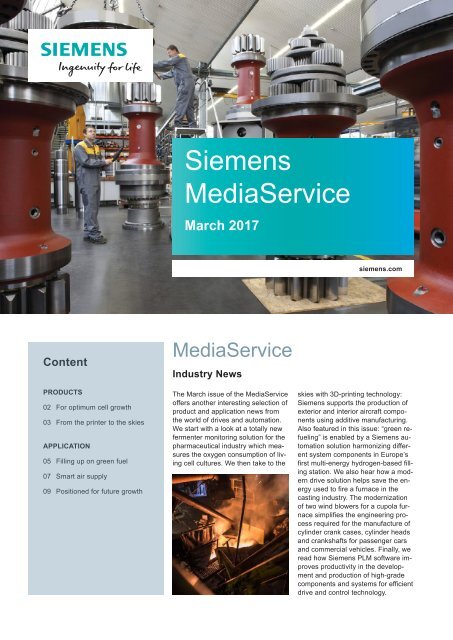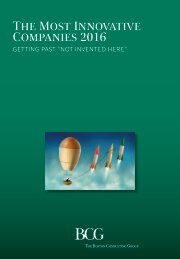Siemens MediaService
2ndp3Qz
2ndp3Qz
Create successful ePaper yourself
Turn your PDF publications into a flip-book with our unique Google optimized e-Paper software.
<strong>Siemens</strong><br />
<strong>MediaService</strong><br />
March 2017<br />
siemens.com<br />
Content<br />
PRODUCTS<br />
02 For optimum cell growth<br />
03 From the printer to the skies<br />
APPLICATION<br />
05 Filling up on green fuel<br />
07 Smart air supply<br />
09 Positioned for future growth<br />
<strong>MediaService</strong><br />
Industry News<br />
The March issue of the <strong>MediaService</strong><br />
offers another interesting selection of<br />
product and application news from<br />
the world of drives and automation.<br />
We start with a look at a totally new<br />
fermenter monitoring solution for the<br />
pharmaceutical industry which measures<br />
the oxygen consumption of living<br />
cell cultures. We then take to the<br />
skies with 3D-printing technology:<br />
<strong>Siemens</strong> supports the production of<br />
exterior and interior aircraft components<br />
using additive manufacturing.<br />
Also featured in this issue: “green refueling”<br />
is enabled by a <strong>Siemens</strong> automation<br />
solution harmonizing different<br />
system components in Europe’s<br />
first multi-energy hydrogen-based filling<br />
station. We also hear how a modern<br />
drive solution helps save the energy<br />
used to fire a furnace in the<br />
casting industry. The modernization<br />
of two wind blowers for a cupola furnace<br />
simplifies the engineering process<br />
required for the manufacture of<br />
cylinder crank cases, cylinder heads<br />
and crankshafts for passenger cars<br />
and commercial vehicles. Finally, we<br />
read how <strong>Siemens</strong> PLM software improves<br />
productivity in the development<br />
and production of high-grade<br />
components and systems for efficient<br />
drive and control technology.
<strong>MediaService</strong> | March 2017 2<br />
For optimum cell growth<br />
<strong>Siemens</strong> components for precision gas analysis in the pharmaceutical industry<br />
The physical differential measurement of<br />
oxygen and carbon dioxide in the supply<br />
and exhaust air flows enables precise<br />
control of the fermentation process.<br />
The modular gas analyzer Siprocess GA700<br />
from <strong>Siemens</strong> is used in what is currently a<br />
unique application in the pharmaceutical industry:<br />
measuring the oxygen consumption<br />
of living cell cultures. The measured results<br />
provide conclusive information about a cell<br />
culture’s “state of health”.<br />
Nuremberg, Germany. In the biological<br />
production of active ingredients,<br />
the quality and yield of the active substances<br />
obtained depend to a large<br />
degree on the correct care of the living<br />
cell cultures used. Their condition can<br />
now be precisely determined using a<br />
new and currently unique method: the<br />
physical differential measurement of<br />
oxygen consumption and carbon dioxide<br />
emissions. To enable this process,<br />
<strong>Siemens</strong> supplies the gas analyzer<br />
Siprocess GA700, a complete solution<br />
comprising the Ultramat 7 analysis<br />
module and the Oxymat 7 measuring<br />
device. Alongside precise analysis results,<br />
this <strong>Siemens</strong> solution offers a<br />
higher degree of process control and<br />
cost savings of up to 50 percent.<br />
In the pharmaceutical industry, a distinction<br />
is drawn between chemical<br />
and biological production used to<br />
manufacture active ingredients. Biological<br />
production is comparatively<br />
more labor-intensive, as it involves living<br />
cell cultures which are kept in<br />
large steel vats known as fermenters,<br />
where they produce the required active<br />
ingredient. The quality and efficiency<br />
of this process depend heavily<br />
on the right care of the living cell cul-<br />
tures. Their “state of health” can be<br />
most efficiently determined by measuring<br />
their oxygen (O2) consumption<br />
and carbon dioxide (CO2) emissions.<br />
This enables the physical<br />
differential measurement of oxygen<br />
and carbon dioxide in the supply and<br />
exhaust air flows. Also part of the<br />
complete solution surrounding the<br />
wear-free measurement principle developed<br />
by <strong>Siemens</strong> is the preparation<br />
of samples. This entails the extraction<br />
and preparation of gases<br />
before feeding them to the analyzer,<br />
a process known as “extractive gas<br />
analytics”. This method of physical<br />
differential measurement is currently<br />
unique in fermenter monitoring, and<br />
will be featured at the <strong>Siemens</strong> booth<br />
(D35) in Hall 9 at this year’s Hannover<br />
Messe from April 24 to 28,<br />
2017.<br />
Precise analysis enables operators<br />
to quickly recognize where optimization<br />
is required and take the necessary<br />
action to adjust the fermentation<br />
process. Process control at this point<br />
can be performed using a Simatic<br />
PCS 7 control system together with<br />
any necessary instrumentation. This<br />
method offers users the best possi-<br />
ble control over the process, an improved<br />
raw material and active ingredient<br />
yield and also up to 50 percent<br />
cost savings per fermenter filling.<br />
Process Gas Analytics<br />
http://w3.siemens.com/mcms/<br />
sensor-systems/en/process-analytics/extractive-continuousprocess-gas-analytics/siprocess-ga700/Pages/Default.<br />
aspx<br />
Ultramat 7<br />
http://w3.siemens.com/mcms/<br />
sensor-systems/en/process-analytics/extractive-continuousprocess-gas-analytics/siprocess-ga700/Pages/<br />
siprocess-ga700-ultramat-7.<br />
aspx<br />
Oxymat 7<br />
http://w3.siemens.com/mcms/<br />
sensor-systems/en/process-analytics/extractive-continuousprocess-gas-analytics/siprocess-ga700/Pages/<br />
siprocess-ga700-oxymat-7.<br />
aspx
<strong>MediaService</strong> | March 2017 3<br />
From the printer to the skies<br />
<strong>Siemens</strong> supports supply of the first 3D-printed aircraft components<br />
Following on from printing of the monitor shrouds, Strata and <strong>Siemens</strong> will turn their attention to another joint project: The construction of an<br />
external aircraft component in metal.<br />
<strong>Siemens</strong> and Strata jointly develop MENA<br />
Region’s first 3D-printed aircraft interior parts<br />
for Etihad<br />
Al-Ain/United Arab Emirates. Although<br />
<strong>Siemens</strong> has already gathered<br />
wide experience in the field of<br />
3D printing, the company recently<br />
broke new ground in cooperation<br />
with aircraft component manufacturer<br />
Strata based in Al-Ain in the United<br />
Arab Emirates: For the very first<br />
time, the company is supporting the<br />
production of exterior and interior<br />
parts for aircraft using 3D-printing<br />
technology. This marks the start of a<br />
partnership with the Mubadala Development<br />
Company, the UAE’s sovereign<br />
wealth fund, to help launch<br />
and develop Industrie 4.0 in the<br />
Emirates.<br />
Additive manufacturing, also known<br />
as 3D printing, is already in use in a<br />
wide range of industrial sectors. This<br />
involves building up components additively<br />
one layer at a time on the<br />
basis of 3D-design data using plastics,<br />
metals and other materials.<br />
Whether burner tips for gas turbines,<br />
armrests for trams or terminal boxes<br />
for Germany’s Deutsche Bahn railway<br />
– <strong>Siemens</strong> has already gathered<br />
plenty of experience in this<br />
technology. Aircraft construction represents<br />
a new field for <strong>Siemens</strong>. The<br />
company supports aircraft component<br />
manufacturer Strata based in<br />
Al-Ain in the United Arab Emirates to<br />
supply elements for use in aircraft<br />
interiors for the first time: shrouds<br />
for the wall monitors used by for Etihad<br />
Airways. To ensure a perfect fit,<br />
these are manufactured with a 3D<br />
printer out of plastic powder. The<br />
monitor shrouds for Etihad are just<br />
the first step in what promises to be<br />
a long-term partnership between<br />
<strong>Siemens</strong> and UAE’s state-owned investment<br />
fund, the Mubadala Devel-
<strong>MediaService</strong> | March 2017 4<br />
opment Company. The aim of this<br />
close future partnership: To support<br />
the United Arab Emirates and North<br />
Africa in the process of introducing Industrie<br />
4.0 and additive manufacturing<br />
with a view to creating an additional<br />
economic mainstay alongside<br />
oil extraction and tourism. In keeping<br />
with this vision, the next order with<br />
Strata is already in the pipeline: After<br />
printing the monitor shroud, Strata<br />
and <strong>Siemens</strong> will work together on<br />
printing an external aircraft component<br />
made of metal. <strong>Siemens</strong> also intends<br />
to support Strata in building a<br />
complete 3D-printing facility.<br />
New ground<br />
For <strong>Siemens</strong>, the monitor shroud contract<br />
posed a whole new set of challenges.<br />
“Before the shroud can be in-<br />
stalled, it has to be approved by the<br />
European Aviation Safety Agency<br />
EASA,” explains Assem Khalaili,<br />
<strong>Siemens</strong> AG’s Head of Industry Customer<br />
Services Middle East. “There<br />
isn’t yet a process in place at <strong>Siemens</strong><br />
for this certification. Luckily<br />
though, we were able to call on our<br />
colleagues in the Mobility Division<br />
who have gained comparable experience<br />
with the certification of parts<br />
used in railway applications, as<br />
these also have to comply with the<br />
highest safety class.” Before the<br />
monitor shrouds “take to the air”,<br />
they and the outside component in<br />
metal will be presented to investors<br />
and decision-makers at the “Global<br />
Manufacturing and Industrialization<br />
Summit Middle East” in March. This<br />
development marks the official<br />
“take-off” for additive manufacturing.<br />
Additive manufacturing<br />
makes its entry into the<br />
world of aviation, as<br />
<strong>Siemens</strong> supports the<br />
3D-printing of aircraft<br />
cabin components for<br />
Etihad Airways.<br />
Additive Manufacturing<br />
http://www.siemens.com/global/<br />
en/home/markets/machinebuilding/additive-manufacturing.html<br />
Service Business Excellence<br />
Portal<br />
https://technoweb.siemens.com/<br />
web/service-business-excellence-portal/overview-strategy
<strong>MediaService</strong> | March 2017 5<br />
Filling up on green fuel<br />
Multi-energy filling station system modules harmonized with <strong>Siemens</strong><br />
Berlin, Germany. Clean Energy Partnership<br />
(CEP) and additional cooperation<br />
partners have launched Europe’s<br />
first ever multi-energy filling station in<br />
Berlin, which supplies hydrogen produced<br />
from wind power and solar energy.<br />
To enable the technology and<br />
systems contributed by the various<br />
partners to be integrated into a stan-<br />
Clean Energy<br />
Clean Energy Partnership is Europe’s<br />
biggest demonstration<br />
project in the field of hydrogen<br />
mobility. Based on the German<br />
Transport Energy Strategy, the<br />
Initiative was launched in the political<br />
arena by the German Ministry<br />
of Transport in 2002 in order<br />
to investigate the system<br />
compatibility of hydrogen as a<br />
fuel in the field of mobility.<br />
dardized operating system, the project<br />
associates opted to use Simatic<br />
PCS 7 technology from <strong>Siemens</strong>.<br />
This automation solution integrates<br />
all the system components without<br />
the need for major changes to the<br />
automation technologies provided by<br />
the individual cooperation partners.<br />
This eliminated the expense which<br />
would have been involved in implementing<br />
an overall synchronization<br />
solution. It allowed the project partners<br />
to adhere to the tight schedule,<br />
secure the intellectual property attached<br />
to the individual parts of the<br />
installation and ensure round-theclock<br />
availability.<br />
“Green” or “clean” energy has long<br />
since ceased to be a novelty, and its<br />
availability is improving all the time.<br />
One reason is completion of the<br />
H2BER project in Berlin, Europe’s<br />
first ever hydrogen-based multi-energy<br />
filling station. The project was<br />
completed under the auspices of the<br />
Clean Energy Partnership (CEP) and<br />
Europe’s first multi-energy filling station in<br />
Berlin is monitored by the Simatic PCS 7<br />
process control system, which also integrates<br />
the components of the different cooperation<br />
partners.
<strong>MediaService</strong> | March 2017 6<br />
other cooperation partners. To allow<br />
the hydrogen to be used across its entire<br />
cycle – from production through<br />
electricity and heat generation to its<br />
use as a fuel – the control systems of<br />
the individual technology partners<br />
needed to be integrated into a standardized<br />
overall system. In concrete<br />
terms, these systems included a combined<br />
heat and power plant to provide<br />
electrical energy and heat for the filling<br />
station, as well as tank technology<br />
for the two hydrogen (H2) fuel dispensers<br />
which will allow passenger<br />
vehicles and buses with 350 bar and<br />
700 bar tanks to be filled in the future.<br />
This harmonization process was made<br />
possible using the higher-level Simatic<br />
PCS 7 process control system from<br />
<strong>Siemens</strong>, which monitors the integrated<br />
system and communicates with the<br />
individual partner modules which supply<br />
hydrogen produced from solar and<br />
wind power.<br />
Everything under a single umbrella<br />
The software technology Open OS,<br />
part of the Simatic PCS 7, is an open<br />
solution which homogenizes heterogeneous<br />
system landscapes by connecting<br />
third-party components such<br />
as CodeSys, Wago, Freelance and<br />
also Simatic S7-1500. For the H2BER<br />
project, this eliminated the need for<br />
an overall synchronization concept.<br />
All the partners were keen to protect<br />
their intellectual property in the form<br />
of patents, trademarks and copyrights.<br />
Open OS guarantees the requisite<br />
degree of protection. The data<br />
required for signal processing is received<br />
from subordinate or ancillary<br />
system components, and is then collated<br />
by the system in a central measuring<br />
station. Individual components<br />
such as programmable logic controllers<br />
(PLCs), third-party controllers<br />
from other manufacturers, or readyto-install<br />
package units can be integrated<br />
using WinCC communication<br />
channels or OPC. This allows OPEN<br />
OS to create a PCS-7-compatible<br />
map of the system requiring integration,<br />
with the result that the plant op-<br />
erator works on a standardized visualization<br />
level. “All the partners<br />
involved worked in close cooperation<br />
right from the start of the project<br />
to agree which information is relevant<br />
and how we could forward<br />
which signals,” explains Wolfgang<br />
Kraus, Project Engineer at McPhy.<br />
“For this pilot project, we solved the<br />
issue by linking the Simatic PCS 7<br />
process control system via Open OS<br />
to the third-party and S7-1500 controllers,<br />
and transmitting the data of<br />
relevance over standard communication<br />
channels.” The structure of<br />
the overall solution comprises an operator<br />
prompting level with clientserver<br />
architecture, some aspects of<br />
which have been configured to be<br />
redundant in the interests of availability.<br />
The lower system level features<br />
an Ethernet ring which is connected<br />
to all the subordinate<br />
systems. This is where OPEN OS<br />
connects the data from third-party<br />
systems, captures it and makes it<br />
available in harmonized form on the<br />
operator prompting level.<br />
Maximum security and availability<br />
Another benefit of the Open OS solution<br />
is that data archiving can be carried<br />
out fully automatically over the<br />
system. Long-term archiving takes<br />
place using the integrated <strong>Siemens</strong><br />
Process Historian Server. Open OS<br />
also permits archiving to take place<br />
in the form of XML files, meaning<br />
that already implemented solutions<br />
can be simply reproduced. This reduces<br />
the engineering effort and cost<br />
input required for future projects,<br />
such as a second H2 filling station.<br />
The comprehensive <strong>Siemens</strong> solution<br />
ultimately not only allowed the<br />
tight schedule to be adhered to but<br />
also ensured the required degree of<br />
intellectual property protection and<br />
twenty-four-seven availability of the<br />
filling station as well as all its systems.<br />
This was all achieved without<br />
the need to make major changes to<br />
the automation technologies used by<br />
the involved partners.<br />
McPhy<br />
McPhy Energy Germany is a<br />
subsidiary company of the<br />
French McPhy Energy S.A.<br />
which was established in 2008.<br />
The company is specialized in<br />
the development and manufacturing<br />
of hydrogen technologies.<br />
At the H2BER filling station<br />
MyPhy operates an<br />
innovative solid-state storage<br />
system (metal hydrides) with a<br />
capacity of 100 kilogramms,<br />
which complements the on-site<br />
compressed gaseous storage.<br />
McPhy was the responsible<br />
project leader for the process<br />
control system of the integrated<br />
manufacturer´s system alliance.<br />
Process Control System<br />
www.siemens.com/simaticpcs7<br />
Intelligent Integration of system<br />
components<br />
http://w3.siemens.com/mcms/<br />
process-control-systems/en/<br />
distributed-control-system-simatic-pcs-7/simatic-pcs-7-technologies/open_os/Pages/<br />
OPEN-OS.aspx
<strong>MediaService</strong> | March 2017 7<br />
Smart air supply<br />
Energy-efficient drive solution for radial blowers in the casting industry<br />
Neue Halberg-Guss GmbH employs a workforce of just under 3,500 around the world and manufactures high-quality cylinder crank cases<br />
from different molten metals.<br />
The Sinamics G120P Cabinet frequency converters<br />
are specifically optimized for the operation<br />
of pumps, fans and compressors.<br />
Saarbrücken, Germany. Neue Halberg-Guss<br />
GmbH (Halberg) based in<br />
Saarbrücken produces cast iron<br />
drive components for the automotive<br />
industry. A recent retrofit involved upgrading<br />
two radial blowers on the cupola<br />
furnace, a shaft furnace used to<br />
smelt metals. Halberg decided to use<br />
an Integrated Drive System (IDS)<br />
from <strong>Siemens</strong>, which has enabled<br />
the company to save around ten percent<br />
in energy costs overall. The<br />
new solution has allowed Halberg to<br />
improve not only the availability and<br />
energy efficiency of the plant, but<br />
also its engineering and safety.<br />
The company Neue Halberg-Guss<br />
GmbH (Halberg) was founded in<br />
1756, and is based in Saarbrücken.<br />
It is Europe’s market and technology<br />
leader in the development and production<br />
of cylinder crank cases, cylinder<br />
heads and crank shafts for<br />
passenger cars and commercial vehicles.<br />
The company processes<br />
180,000 tons of iron every year, from<br />
the smelting stage at temperatures<br />
of 1,500 degrees Celsius to castings<br />
used in diesel and petrol engines.<br />
The nerve center of the plant is the<br />
18-meter high cupola furnace, whose<br />
availability directly impacts on the<br />
whole of the linked production process.<br />
As part of on-going maintenance<br />
work on the furnace, two radial<br />
fans had to be retrofitted, and are<br />
now equipped with Integrated Drive<br />
Systems (IDS) from <strong>Siemens</strong>. “We<br />
attach a high level of importance to<br />
our maintenance program, which is<br />
why we undertake a lot of modernization<br />
work. In this way, we foster<br />
and promote availability, efficiency,<br />
economy and importantly also environmental<br />
awareness,” explains Halberg’s<br />
Head of Electrical Maintenance<br />
Michael Steuer.<br />
Well integrated overall system<br />
The blowers each supply up to<br />
24,000 standard cubic meters of air<br />
per hour, ensuring an uninterrupted<br />
smelting process. They are driven by<br />
Simotics FD motors with a maximum<br />
output of 325 Kilowatts (kW) and<br />
Sinamics G120P Cabinet frequency
<strong>MediaService</strong> | March 2017 8<br />
converters, which together form an<br />
IES2 energy efficiency class drive<br />
train in compliance with EN50598-2.<br />
This allows Halberg to make energy<br />
cost savings of up to ten percent in<br />
running operation. This has enabled<br />
98 percent efficiency to be achieved,<br />
five percent up compared to the previously<br />
used fan motors. The frequency<br />
converters can now also be run in<br />
energy saving mode, or switched<br />
off altogether and switched back on<br />
remotely as required over the Profi-<br />
Energy communication profile. For<br />
motor dimensioning and to determine<br />
which motors would fulfill the required<br />
performance characteristics, Halberg<br />
used the <strong>Siemens</strong> energy saving tool<br />
SinaSave. On this basis, the decision<br />
was taken to opt for Sinamics G120P<br />
Cabinet with 315 kW and the threephase<br />
induction motor Simotics FD<br />
High Efficiency with a shaft height of<br />
315 and 325 kilowatts. This choice enabled<br />
the company to actually go<br />
down a step to a smaller motor size. It<br />
also meant improved values in terms<br />
of moment of inertia, moveable mass<br />
and efficiency. Another benefit of Simotics<br />
FD motors is their smart modular<br />
system concept which offers outstanding<br />
flexibility with a wide range of<br />
possible applications. One of the<br />
many ventilation options uses internal<br />
cooling fins which prevent contamination<br />
by dirt deposits from the ambient<br />
air during motor standstill periods,<br />
making them ideal for use in harsh environments<br />
such as the Halberg<br />
foundry.<br />
Simple programming<br />
Using the Step 7 programming software<br />
and the integrated commissioning<br />
tool Starter, motors and converters<br />
can be ideally coordinated at the<br />
press of a button, resulting in an improved<br />
degree of system efficiency.<br />
Because the frequency converters allow<br />
the measurement distances of the<br />
analog pressure sensors from the air<br />
channels to be fed directly to the relevant<br />
inputs at the frequency converter,<br />
a dynamic and independent subsystem<br />
is created through the integrated<br />
PID (Proportional Integral Derivative)<br />
controller. This does not need to be<br />
programmed in the higher-level programmable<br />
logic controller (PLC),<br />
which forwards the energy consumption<br />
values via the OPC (Open Platform<br />
Communication) interface, so<br />
saving valuable computing performance.<br />
Wide-ranging improvements<br />
Alongside improving energy efficiency,<br />
the retrofit has also enabled availability<br />
to be significantly improved.<br />
Instead of the two separately operated<br />
redundant drives used in the past,<br />
the new motors can be individually<br />
switched over, with alternating supply<br />
by converter 1 or 2. Logging operating<br />
hours according to maintenance<br />
aspects allows the ideal load distribution<br />
to be achieved. Against the backdrop<br />
of improvements in terms of<br />
availability, engineering and energy<br />
consumption, Halberg intends to<br />
make further use of <strong>Siemens</strong> technology<br />
for planned modernization projects<br />
in other areas.<br />
The wind blowers for the cupola furnace<br />
were retrofitted using an Integrated Drive<br />
Solution (IDS) comprising Sinamics G120P<br />
frequency converters and Simotics FD<br />
motors.<br />
Converter<br />
www.siemens.com/sinamcis<br />
Integrated Drive Systems<br />
www.siemens.com/ids<br />
Motors<br />
www.siemens.com/simotics
<strong>MediaService</strong> | March 2017 9<br />
Positioned for future growth<br />
Component manufacturer improves productivity with <strong>Siemens</strong> PLM Software<br />
The <strong>Siemens</strong> PLM Software solution is customizable to meet customer requirements and can be seamlessly integrated with Liebherr’s existing<br />
operational data acquisition system.<br />
Biberach, Germany. Liebherr-Components<br />
Biberach GmbH (Liebherr) develops<br />
and manufactures high-quality<br />
components and systems for high-performance<br />
drive and control technology.<br />
For the continuous improvement of its<br />
quality processes, Liebherr uses IBS<br />
QMS Software from PLM (product lifecycle<br />
management) specialist <strong>Siemens</strong><br />
PLM Software. The solution enables<br />
the company to implement optimal<br />
transparency and to improve its manufacturing<br />
productivity.<br />
Liebherr-Components Biberach<br />
GmbH (Liebherr) is part of the components<br />
division of the Liebherr<br />
Group, which developed the first<br />
quickly transportable and easily<br />
erected revolving tower crane over<br />
six decades ago. Today the company<br />
manufactures technically sophisticated<br />
high-performance drive components,<br />
such as large diameter bearings,<br />
gearboxes and rope winches,<br />
as well as electrical machines and<br />
switchgears. These components are<br />
used in products such as earthmoving<br />
machines, wind turbines, mining<br />
equipment, maritime applications<br />
and vehicle systems. In order to<br />
safeguard its reputation for producing<br />
high-quality products, the company<br />
always uses IBS QMS Software<br />
from <strong>Siemens</strong> PLM Software to monitor<br />
and document the production<br />
processes, to achieve transparency<br />
and to improve manufacturing productivity.<br />
Choosing a reliable solution<br />
Comprehensive analysis and evaluation functionality in IBS QMS supports continuous quality<br />
and productivity improvement.<br />
Until 2003, Liebherr used a manual<br />
process for acquiring and evaluating<br />
quality data. Liebherr then decided to<br />
introduce an integrated computeraided<br />
quality (CAQ) and manufacturing<br />
execution system (MES) solution<br />
that would elevate process transparency,<br />
minimize administrative costs,<br />
increase production and individual<br />
worker responsibility, include a solution<br />
for concern and complaint management<br />
and allow the company to<br />
integrate a batch tracking system.<br />
Additionally, the CAQ/MES solution<br />
needed to be seamlessly integrated<br />
with Liebherr’s existing operational<br />
data acquisition (ODA) and enter-
<strong>MediaService</strong> | March 2017 10<br />
Liebherr manufactures technically sophisticated high-performance drive components, such as large diameter bearings, gearboxes and rope<br />
winches, as well as electrical machines and switchgear.<br />
prise resource planning (ERP) systems.<br />
In November 2003, Liebherr selected<br />
IBS QMS software from<br />
<strong>Siemens</strong> PLM Software. Key decision<br />
factors included the ability to customize<br />
the solution to meet customer-specific<br />
needs and the seamless integration<br />
with existing ODA and ERP<br />
systems.<br />
Eliminating duplication<br />
In May 2004, Liebherr implemented<br />
IBS QMS and initiated training<br />
for approximately 700 employees<br />
using 100 terminals in the large<br />
diameter bearings, gearbox and<br />
crane technology departments. With<br />
a user-friendly operating interface,<br />
Liebherr can achieve a high degree<br />
of integration and eliminate duplicate<br />
data entry. Production orders are<br />
sent from the ODA system to IBS<br />
QMS, triggering respective inspection<br />
processes. Using touchscreen<br />
terminals, operators can determine<br />
which orders are being processed at<br />
any given machine as well as the<br />
current manufacturing status of each<br />
order. Inspection results are acquired<br />
and reviewed in parallel with production<br />
processes for further analysis.<br />
Only after processing all CAQ<br />
characteristics can the production<br />
order be closed.<br />
Certifying results<br />
The ability to continually monitor<br />
each component throughout manufacturing<br />
helps Liebherr identify<br />
trends early in the process. In addition<br />
to defect avoidance, the main<br />
emphasis is on the continuous improvement<br />
process (CIP) for products<br />
and procedures. At the request<br />
of the customer, Liebherr can generate<br />
individual certificates to substantiate<br />
processing results.<br />
Enhancing traceability and<br />
transparency<br />
The documentation and allocation of<br />
batch and serial numbers enable<br />
identification of individual stages<br />
throughout the part production process<br />
and allow Liebherr to track all<br />
batches. Internal complaints are<br />
managed with QMS Concern and<br />
Complaint Management (CCM),<br />
which allows Liebherr to prioritize the<br />
processing of once-defective parts<br />
that have been corrected. By using<br />
QMS CCM, Liebherr can document<br />
actions and allocate costs, such as<br />
rework, increasing transparency and<br />
enabling the identification and rapid<br />
elimination of weak points. The comprehensive<br />
analysis and evaluation<br />
functionality in IBS QMS supports<br />
continuous quality and productivity<br />
improvement. “IBS QMS helps us improve<br />
process transparency and positions<br />
Liebherr for future growth,”<br />
says Jürgen Stuhlmüller, quality assurance<br />
manager at Liebherr. On<br />
this recommendation, other Liebherr<br />
sites have also selected <strong>Siemens</strong><br />
PLM Software as their CAQ/MES solution<br />
provider.<br />
PLM Software<br />
www.siemens.com/plm<br />
Quality Management<br />
www.siemens.com/mom/ibsqms
<strong>MediaService</strong> | March 2017 11<br />
<strong>Siemens</strong> AG (Berlin and Munich) is a global technology<br />
powerhouse that has stood for engineering<br />
excellence, innovation, quality, reliability and internationality<br />
for more than 165 years. The company<br />
is active in more than 200 countries, focusing on<br />
the areas of electrification, automation and digitalization.<br />
One of the world’s largest producers of energy-efficient,<br />
resource-saving technologies,<br />
<strong>Siemens</strong> is a leading supplier of efficient power generation<br />
and power transmission solutions and a pioneer<br />
in infrastructure solutions as well as automation,<br />
drive and software solutions for industry. The<br />
company is also a leading provider of medical imaging<br />
equipment – such as computed tomography<br />
and magnetic resonance imaging systems – and a<br />
leader in laboratory diagnostics as well as clinical<br />
IT. In fiscal 2016, which ended on September 30,<br />
2016, <strong>Siemens</strong> generated revenue of €79.6 billion<br />
and net income of €5.6 billion. At the end of September<br />
2016, the company had around 351,000<br />
employees worldwide. Further information is available<br />
on the Internet at www.siemens.com.<br />
<strong>MediaService</strong>:<br />
www.siemens.com/press/en/materials/mediaservice.php<br />
<strong>MediaService</strong> Digithek:<br />
http://press-mediaservice.com/digithek/<br />
<strong>MediaService</strong> application reports may be based on<br />
previously published <strong>Siemens</strong> technical articles.<br />
Press Contact:<br />
Process Industries and Drives<br />
Stefan Rauscher<br />
Tel.: +49 (0)911 - 895 7952<br />
stefan.rauscher@siemens.com<br />
David Petry<br />
Tel.: +49 (0)9131 7 - 26616<br />
david.petry@siemens.com<br />
Digital Factory<br />
Evelyne Kadel<br />
Tel.: +49 (0)211 - 6916 1003<br />
evelyne.kadel@siemens.com<br />
Claudia Lanzinger<br />
Tel.: +49 (69) 480052 - 404<br />
claudia.lanzinger@siemens.com<br />
Gerhard Stauß<br />
Tel.: +49 (0)911 - 895 7945<br />
gerhard.stauss@siemens.com<br />
Contact <strong>MediaService</strong><br />
Ursula Lang<br />
Tel.: +49 (0)911- 895 7947<br />
ursula.lang@siemens.com<br />
Current press releases:<br />
<strong>Siemens</strong>: www.siemens.com/press<br />
<strong>Siemens</strong> PLM Software:<br />
www.plm.automation.siemens.com/en_us/about_us/<br />
newsroom//<br />
<strong>Siemens</strong> industry topics on Social Media<br />
<strong>MediaService</strong> Industries Blog:<br />
https://blogs.siemens.com/mediaservice-industries-en/<br />
Twitter: https://twitter.com/siemensindustry<br />
YouTube: www.youtube.com/<strong>Siemens</strong>









